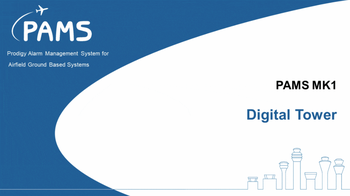Group Alarm Server
PAMS Group Alarm Server provides a supervisory system for multiple PAMS Site Systems so that a central overview of several airports or airfields can be presented. Group Alarm Server provides an overview display of the status of all monitored sites and the ability to view the full status display of any individual site. Group Alarm Server also consolidates all alarm status event data making it possible to view and analyse alarm history over any period.
System Overview

PAMS Group Alarm Server links to the remote PAMS Site Systems typically through a WAN connection. A local display with keyboard and mouse provides an interface for the system administration.
Additional access to the system can be provided for other users through PAMS Workstations that are connected to the PAMS Group Alarm Server through the local site LAN connection.
All of the current alarm status information at each of the PAMS Site Systems is transferred in real time to the PAMS Group Alarm Server.
Site Alarm Recordings
Remote PAMS Site Systems record all site alarm events into the local alarms databases. These are then be accessed by the PAMS Group Alarm Server so that a master alarms database is automatically maintained which provides a single source of all alarm events across all sites for analysis.
In the event of the failure of a network connection to a site system that site will continue to record alarm data locally. When that system is next detected on the network all alarm data since the last transfer was completed is copied to the PAMS Group Alarm Server database.
NTP Time Source
The system time is synchronised with a customer designated time source. This uses standard MS Windows functionality to access a gateway hub with a fixed IP address.The gateway hub then automatically switches between a primary and secondary time source as required.
PAMS Systems are designed for continuous operation, 24 hours per day, 365 days per year without the need for any regular systems administration.
Alarm Control Panel
The Alarm Control Panel is the main user display and is presented automatically at system start up. Each site is represented as a single button on the main Alarm Control Panel display. The colour of the button changes depending upon its current status, alarm detection, acknowledgement and reversion.
In the event of an alarm condition being indicated for a site, the user is able to accept the alarm and in pressing the button to accept the alarm, the system switches to a site specific display which shows the individual states of all of the alarm input channels for the site. The user may accept overall site active and un-acknowledged alarms using the touch screen display or mouse by clicking on the individual alarm buttons.
It is not possible to accept the individual alarms that occur on a PAMS site system through the displays on the Group Server. If alarms need to be acknowledged on the PAMS site systems remote access software can be used to log on to the site systems and accept the alarms directly on the system.
Alarms conditions which are accepted but remain active can be re-triggered to draw attention to the issue using the Alarm Nag functionality. This is defined as a period of time for an alarm to be active and accepted before it is re-triggered. The default setting will be a 0s Nag period (i.e. no Nag will occur).
Information related to alarm input channels can be accessed by clicking on the information icon. This will result in a pdf document being displayed that can be used to contain all relevant information and the actions that should be taken in the event of alarm inputs being active.
Alarm Report
The system holds all alarm events for all remote PAMS Site Systems in an Alarm History Database, including:
- Every alarm occurrence
- Each alarm acknowledgement (and by whom)
- Each time an alarm input channel reverts to normal
Each entry into the database will have a Site ID, date, time, and logged on user ID appended to it.
The Alarm Report feature then allows the user to select any time period from minutes to months and a tabular alarm report is generated using the data. It also includes filter options to allow the user to select certain entry types (such as just alarm comments) or alarm groups to focus on just one area of interest.
The report uses colour to differentiate the different types of entry such as alarm occurrence, acceptance etc. It is previewed on the display and from there the user may send it to the default network printer for a hard copy.


